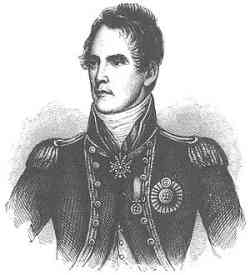James Lucas Yeo |
|
|---|---|
| Born | 10/7/1782 in Southampton, England |
| Died | 8/21/1818 in At sea, off the coast of Africa |
Biography |
|
Yeo was born in Southampton on 7 October 1782, and joined the Royal Navy as a midshipman at the age of 10. He first saw action as a lieutenant aboard a brig in the Adriatic Sea, and distinguished himself during the siege of Cesenatico in 1800. He participated in several sea battles during the Napoleonic Wars, so successfully that he was made a post captain at the age of 25. In 1810, he was knighted for his services at the Invasion of Cayenne. In 1812, he commanded the frigate HMS Southampton, then stationed in the Bahamas. He captured the pirate ship Heureuse Réunion at the Action of 3 February 1812 and the American brig USS Vixen in November 1812, but shortly afterwards Southampton and Vixen were wrecked in the Crooked Island passage, although no lives were lost. As was customary in the case of the loss of a ship from any cause, Yeo was court martialled, but the court accepted that the reef on which he was wrecked was not charted, nor were the local currents documented, and Yeo was exonerated. He was sent to Canada to command the British naval forces in the Great Lakes during the War of 1812. Sir James's use of his small navy was always determined and skilful, but he was hampered by a lack of cooperation from the British army. The commander of these forces, Sir George Prevost, failed to follow up key advances made by Sir James at Sackett's Harbour and elsewhere that might have resulted in major British victories. On the whole, historians regard the war on Lake Ontario as having been a draw. During the final months of the war, Yeo ensured British control of the lake by the 1814 launch of the HMS St. Lawrence, a 112 gun first rate ship of the line built in Kingston specifically for use on the lake. After the British-American War, Yeo held important commands on the West African and Caribbean stations, but saw no further action. He died in 1818 at the age of 35, while returning from Jamaica to England. |
|
 Sir James Lucas Yeo (7 October 1782 – 21 August 1818) was a British naval commander who served in the War of 1812.
Sir James Lucas Yeo (7 October 1782 – 21 August 1818) was a British naval commander who served in the War of 1812.